The Samsung 950 Pro PCIe SSD Review (256GB and 512GB)
by Billy Tallis on October 22, 2015 10:55 AM ESTMixed Random Read/Write Performance
Most real-world use consists of a mix of reads and writes, and interleaving the two often poses a particular challenge to drive controllers. This mixed random access test is conducted across a 16GB span of the drive, but on a full drive and with a queue depth of 3.
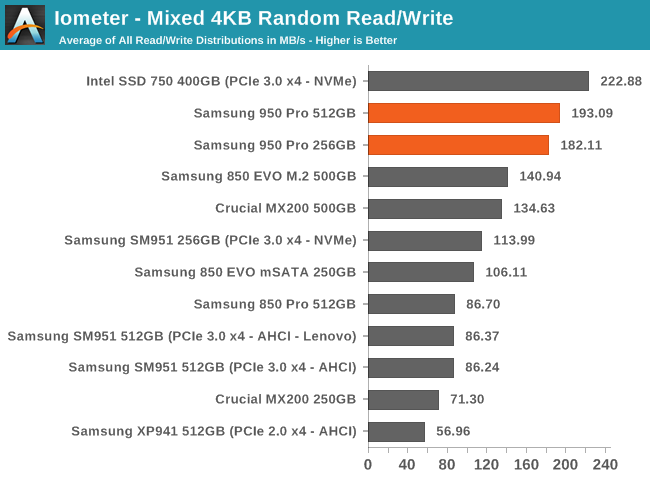
Mixed random access seems much improved over Samsung's earlier M.2 drives, and the 950 Pros fall behind only the Intel SSD 750. The 512GB drive is well behaved here and surpassing the 256GB drive as it should.
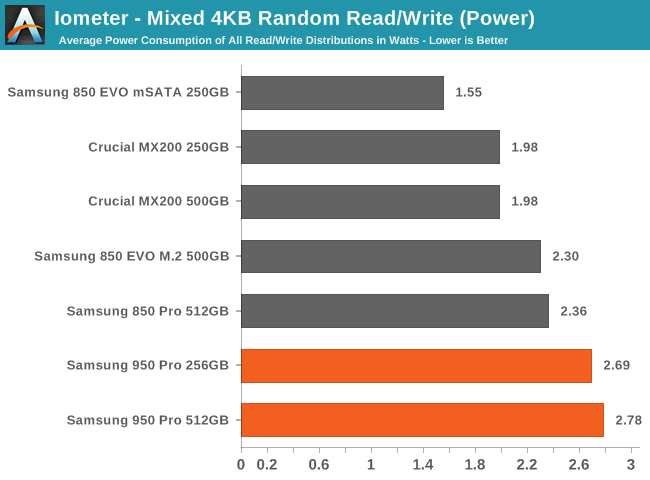
In this case, the higher power consumption of the 950 Pro is very well justified by the higher performance.
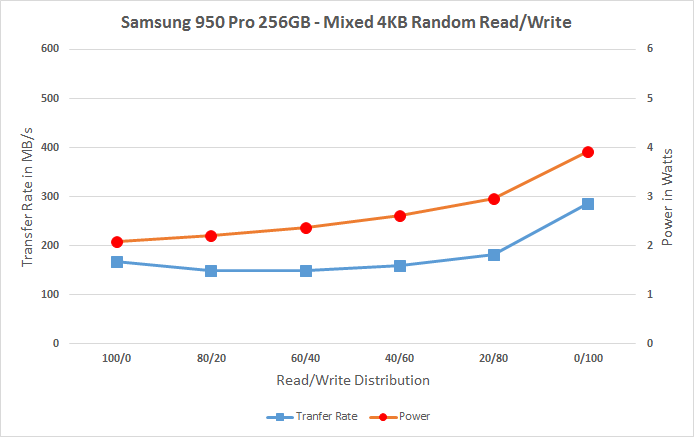 |
|||||||||
There's not much variation across the different workloads. Performance hardly drops during the middle of the test where many controllers have trouble with a balanced mix, but on the other hand the performance at either end of the test is nothing spectacular. Power consumption climbs hand in hand with the proportion of writes, but is accompanied by some increasing in overall data rate.
Mixed Sequential Read/Write Performance
The queue depth of 3 is sufficient for many drives to perform very well at either end of this test, while testing 100% reads or 100% writes. In between, performance typically suffers greatly, and that's where the winners and losers of this test are determined. Anything that's duplicating duplicating or transforming a large amount of data on the drive will produce I/O patterns similar to this test. Creating a System Restore snapshot, backing up files to a different directory on the same drive, and file compression can all produce interleaved reads and writes of large blocks of data, though not necessarily fast enough to be limited by the drive's performance.
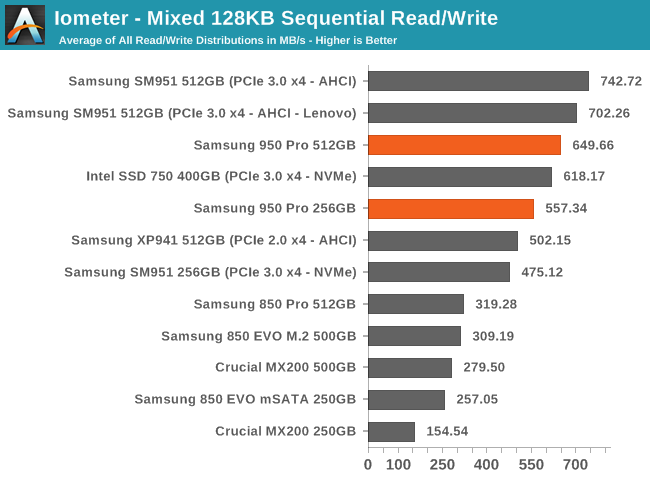
These sequential workloads allow the PCIe drives to stand out and achieve average speeds that would saturate SATA.
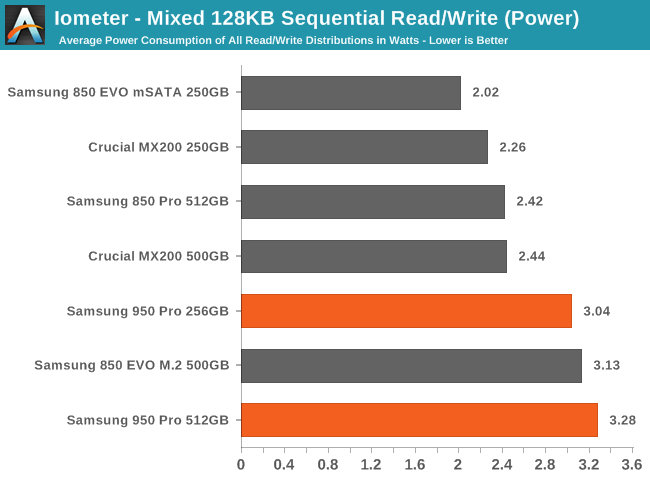
With power consumption in the same neighborhood as the SATA drives, the 950 Pro is significantly more efficient.
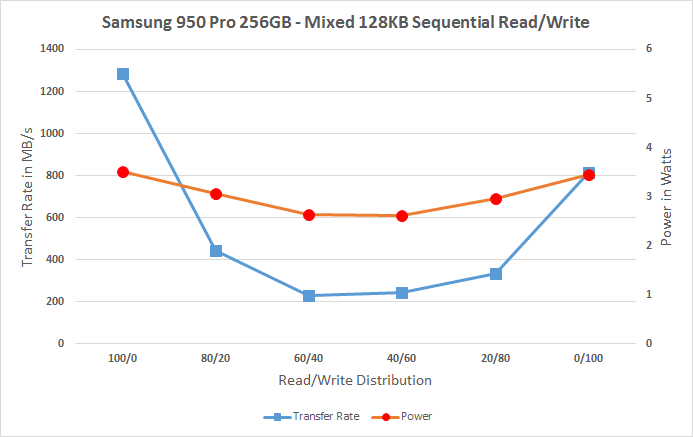 |
|||||||||
Looking at the breakdown by workload, the 950 Pro performs well on the balanced mixes and far outstrips the SATA limit on the very read-heavy workloads and the pure write section at the end of this test.










142 Comments
View All Comments
MHz Tweaker - Monday, November 16, 2015 - link
I have an IT service company and have been doing IT for a few decades. I am with you on how incredibly annoying it is to work on some of the hodge podge of hardware that comes in for service. Specifically there are those that refuse to upgrade early P4's or Sempron single core systems with 512 or 256 megs of RAM. Certainly these should have failed by now. They barely run XP let alone modern security needed to protect them. Internally all our workstations are Z97, X99, x79, Z170's with 4690K's, 4790K's, 5930K, 3930K and 6700K CPUs. Every machine has a Samsung or Intel SSD for a boot drive and a Hitachi 4, 5 or 6TB drive for work and storage. All systems also have 16 or 32GB RAM. I am just amazed at how much time the average person wastes waiting on an entry level PC to do things. I mean many of us spend in excess of 40 hours a week at a keyboard. I get much more done when I keep my equipment in tip top shape and fresh. Nothing has a chance to break down. Many companies throw tons of money at "image" but internally the infrastructure is held together with bubble gum and band aids.Oh BTW, I got our first 950 Pro 512MB Yesterday :-)
Deders - Thursday, October 22, 2015 - link
Until Samsung announce again that SSD's are not meant to use sleep, their excuse for computers with 830/840's freezing for 30 seconds after waking up.BurntMyBacon - Friday, October 23, 2015 - link
@Deders: "Until Samsung announce again that SSD's are not meant to use sleep, their excuse for computers with 830/840's freezing for 30 seconds after waking up."Is this a known issue or are you just speculating about what might (probably?) occur in the future?
I am using quite a few 830s and have deployed quite a few more all (up to this point) without this issue. In my experience, they've been some of the most reliable drives I've used. I know of a few 840s without issues as well, but I've tried to avoid them as much as practical as I'm still not convinced the industry fully understands the long term consequences of simultaneously increasing leakage and cutting down the margin of error to get that third (fourth, fifth, etc.) bit in. I suspect it'll be fine on some (larger) process nodes, but the 840EVO issues suggests that there is a lower limit to how small you can get while trying to get that extra bit (and storing long term). In any case, it would be nice to know if there is something I should be looking out for here and whether practical mitigations exist.
bill.rookard - Sunday, October 25, 2015 - link
Agreed. I have several systems with the 830s in them and have zero problems with them. I avoided the 840s because those went with the TLC and I was iffy about them, and the 830s are rock solid and very fast.Chaser - Tuesday, October 27, 2015 - link
Boot times matter to me too. Makaveli must have a remote control while he's making his bagels.carl0ski - Monday, May 16, 2016 - link
I'd say the most annoying part is the Windows boot logo is a fixed time to complete.So even if Windows 7 8 10 boot up faster it still waits for the pretty video.
Turn it off from msconfig and windows 7 on 850 will boot in 3 seconds instead of 10 seconds
beginner99 - Thursday, October 22, 2015 - link
Most people that buy such a product usually are enthusiast and play around like over clocking. 10 sec more per boot is then pretty annoying.Makaveli - Thursday, October 22, 2015 - link
I'm from the era of overclocking with jumpers on a motherboard and far longer post times. If waiting 10 seconds for a machine to boot is too long while trying to get a stable overclock then do it in windows. Or does everyone in this generation have ADD?AnnonymousCoward - Thursday, October 22, 2015 - link
Oh, so time is only valuable to those with ADD? You're a fool.Makaveli - Thursday, October 22, 2015 - link
Go troll else where tool!